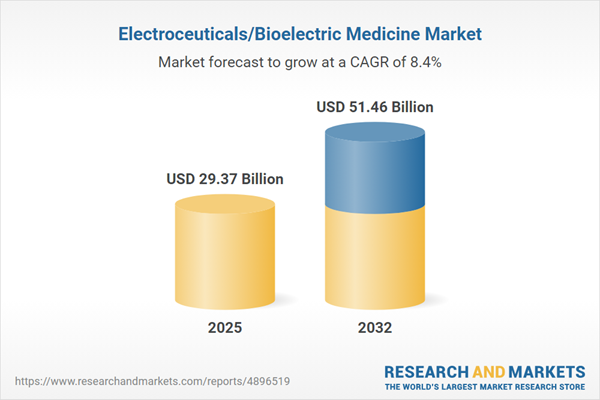Speak directly to the analyst to clarify any post sales queries you may have.
Senior healthcare executives increasingly recognize the strategic value of the Electroceuticals/Bioelectric Medicine Market as they seek clinical innovation that supports non-pharmacological approaches and strengthens organizational performance. This evolving landscape provides a platform for adaptive care, improved patient outcomes, and an agile operational model—all key priorities for decision-makers in the healthcare sector.
Market Snapshot: Electroceuticals/Bioelectric Medicine Market
The global Electroceuticals/Bioelectric Medicine Market is projected to expand from USD 27.05 billion in 2024 to USD 29.37 billion in 2025 and is anticipated to reach USD 51.46 billion by 2032, with a compound annual growth rate of 8.36%.
This growth is fueled by sustained investment in research and the increasing integration of bioelectric therapies in clinical environments. Advancements in digital health and broader adoption across both hospitals and ambulatory settings underpin the market’s resilience. Market stakeholders maintain competitiveness through ongoing research and development initiatives, strategic alliances, and digital strategy enhancements. Evolving regulatory landscapes and diverse patient needs continue to underline the market's long-term relevance in healthcare delivery.Scope & Segmentation: Strategic Opportunities for Senior Leaders
A comprehensive segmentation of the Electroceuticals/Bioelectric Medicine Market enables leaders to navigate resource planning, evaluate partnerships, and identify risk mitigation opportunities. This segmentation structure aligns with dynamic clinical, regulatory, and technological requirements globally.
- Technologies: Deep brain stimulation, spinal cord stimulation, vagus nerve stimulation, transcranial magnetic stimulation, transcutaneous electrical nerve stimulation, gastric electrical stimulation, and sacral nerve stimulation—all designed to deliver precise interventions for neurological and chronic health issues.
- Applications: Cardiology, neurology, gastroenterology, pain management, and urology, which benefit through enhanced diagnostics, improved therapeutic outcomes, and patient engagement innovations.
- Device Types: Implantable electrodes, pulse generators, non-invasive stimulators, and wearable devices, supporting fluid clinical workflows and facilitating both continuous and hybrid monitoring practices.
- End Users: Hospitals, ambulatory surgical centers, specialty clinics, and home care providers—offering scalable implementation across institutional and patient-focused settings.
- Indications: Chronic pain, depression, epilepsy, migraines, Parkinson’s disease, and urinary incontinence, ensuring leaders can target investments and optimize operational strategies.
- Modes: Invasive and non-invasive modalities allow organizations to tailor treatment approaches in line with patient preferences and specific site requirements.
- Geographies: Targeted regions include the Americas, EMEA, and Asia-Pacific, with attention to major healthcare markets such as the United States, Brazil, Canada, Germany, the United Kingdom, Saudi Arabia, South Africa, China, India, Japan, Australia, and Singapore to inform compliance and market access planning.
- Key Players: Medtronic plc, Abbott Laboratories, Boston Scientific Corporation, LivaNova PLC, Nevro Corp., Biotronik SE & Co. KG, Axonics, Inc., Zynex, Inc., ElectroCore, Inc., and NeuroMetrix, Inc.—leaders contributing expertise and innovation across multiple therapeutic fronts.
Key Takeaways for Executive Strategy
- Establishing electroceutical devices within care pathways encourages collaboration among device manufacturers, clinical providers, and digital health partners, streamlining clinical coordination and promoting operational agility.
- Broad integration of neuromodulation technologies permits expansion into emerging therapies and diversification of the organizational service portfolio while enabling adaptation to future clinical trends.
- Focus on interoperability and digital solutions acts as a lever for improved cross-organization alignment, optimizing care transitions and supporting the shift to value-based models.
- Deployment of wearable and non-invasive devices increases accessibility for remote and hybrid care solutions, driving efficient and patient-centric care delivery formats.
- Continuous refinement of compliance and business frameworks is necessary as organizations respond to changing policy conditions and evolving reimbursement structures in diverse markets.
Tariff Impact on Innovation and Supply Chain Resilience
Recent changes in U.S. tariff policies affecting electroceutical components have resulted in increased procurement expenses and added complexity to global supply chain management. To address these challenges, healthcare organizations are actively expanding supplier networks, sourcing more regionally, and prioritizing research and development initiatives. Enhanced risk management and supplier diversity support sustained innovation and protect day-to-day operations from market disruptions.
Methodology & Data Sources
This report is informed by more than fifty structured interviews with leaders from clinical, procurement, and technology disciplines. Findings are regularly validated by regulatory reviews and expert consultations to ensure accuracy and actionable value in all strategic recommendations.
Why This Report Matters
- Guides decision-makers through shifts in clinical and technology trends, supporting effective strategic alignment with organizational objectives.
- Delivers insight into segmentation and regional dynamics to ensure efficient resource allocation and pathway optimization.
- Facilitates proactive risk management concerning regulatory changes and supply chain uncertainties, so teams can maintain operational momentum.
Conclusion
The Electroceuticals/Bioelectric Medicine Market provides actionable market insight for executive teams, equipping them to adapt, make informed decisions, and drive growth through precise, evidence-based strategy shifts.
Additional Product Information:
- Purchase of this report includes 1 year online access with quarterly updates.
- This report can be updated on request. Please contact our Customer Experience team using the Ask a Question widget on our website.
Table of Contents
3. Executive Summary
4. Market Overview
7. Cumulative Impact of Artificial Intelligence 2025
Companies Mentioned
The companies profiled in this Electroceuticals/Bioelectric Medicine market report include:- Medtronic plc
- Abbott Laboratories
- Boston Scientific Corporation
- LivaNova PLC
- Nevro Corp.
- Biotronik SE & Co. KG
- Axonics, Inc.
- Zynex, Inc.
- ElectroCore, Inc.
- NeuroMetrix, Inc.
Table Information
| Report Attribute | Details |
|---|---|
| No. of Pages | 182 |
| Published | October 2025 |
| Forecast Period | 2025 - 2032 |
| Estimated Market Value ( USD | $ 29.37 Billion |
| Forecasted Market Value ( USD | $ 51.46 Billion |
| Compound Annual Growth Rate | 8.3% |
| Regions Covered | Global |
| No. of Companies Mentioned | 11 |









